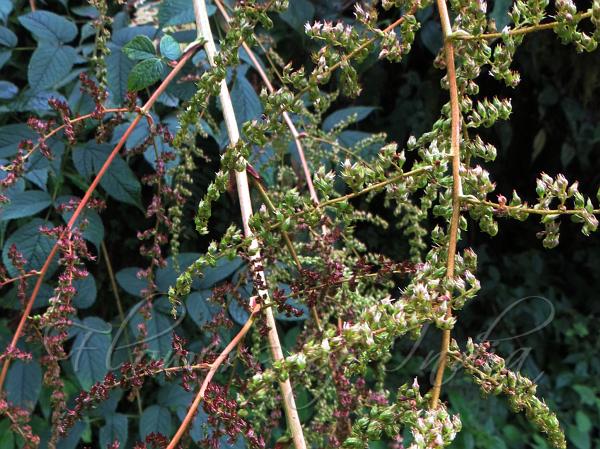|
| River Astilbe |
|

|

| File size | 786660 |
| Original date | 10/5/12 9:16 AM |
| Resolution | 2048 x 1536 |
| Flash | Flash did not fire, auto |
| Focal length | 4.5mm |
| Exposure time | 1/60s |
| Aperture | 4.0 |
| Focus Distance | |
| Metering Mode | Multi-segment |
| Camera make | Canon |
| Camera model | Canon PowerShot SX260 HS |
| Sensor type | OneChipColorArea |
|
|
|
|
Photo: |
Botanical name: Astilbe rivularis Family: Saxifragaceae (Saxifrage family)
Synonyms: Astilbe indica, Astilbe speciosa
Synonyms: Astilbe indica, Astilbe speciosa
River Astilbe is a herb 1-1.5 m tall. Leaves are
compound, lower leaflets usually further divided. Leaflets are 3-5, 3-8
cm long, ovate, long-pointed, base sometimes heart-shaped, stalked to
stalkless, rough, especially on the veins. Leaf-stalks and rachis are
covered with long hairs, tufted at the base of leaflet-stalks.
Stipules are about 1 cm long, adnate to the leaf-stalk. Flowers are
borne in long terminal branch pyramidal clusters of tiny greenish
yellow
flowers. Peduncle is glandular villous. Flowers are bracteate, bracts
lanceshaped, about 2 mm long. Sepals are 5,1.5 mm long, ovate, basally
adnate to the ovary, persistent. Petals are absent. Stamens are 5,
opposite the sepals, filaments 2.5 mm long. Carpels are connivent,
oval, about 1.5 mm, each prolonged into a short style, less than 1 mm
long. Capsules are about 4 mm long, splitting longitudinally into 2
valves. Seeds are numerous, 2 mm long, tailed at both ends. River
Astilbe is found in the Himalayas, from Kashmir to Bhutan, Assam, S.
Tibet, Thailand, N. Indo-China, W. China, at altitudes of 2000-3600 m.
Flowering: June-September.
Medicinal uses: In traditional medicine, the
juice of the plant is applied to sprains and swellings. Root paste is
mixed with honey and taken to control post-partum diarrhoea and
dysentery.
In traditional medicine, the
juice of the plant is applied to sprains and swellings. Root paste is
mixed with honey and taken to control post-partum diarrhoea and
dysentery.
Medicinal uses:
 In traditional medicine, the
juice of the plant is applied to sprains and swellings. Root paste is
mixed with honey and taken to control post-partum diarrhoea and
dysentery.
In traditional medicine, the
juice of the plant is applied to sprains and swellings. Root paste is
mixed with honey and taken to control post-partum diarrhoea and
dysentery. | Identification credit: Sanjyoti Subba | Photographed in Fambong-Lho Wildlife Sanctuary, Sikkim. |
• Is this flower misidentified? If yes,